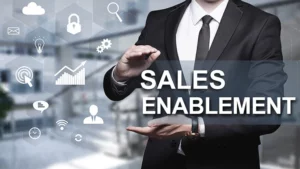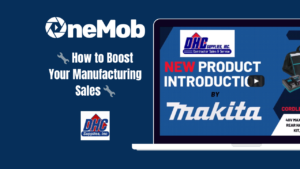Introduction
As the sales landscape continues to evolve, businesses are turning to sales enablement strategies to boost revenue and drive growth. Sales enablement refers to the process of equipping sales teams with the tools, resources, and knowledge they need to effectively engage with customers and close deals. By providing sales reps with the right support, organizations can help them build stronger relationships with customers, increase efficiency, and ultimately drive revenue growth.
According to recent studies, companies with effective sales enablement strategies experience a significant boost in revenue and growth. In fact, businesses with a formal sales enablement function experience a 350% higher win rate and 50% higher quota attainment than those without. Additionally, organizations with sales enablement strategies see an 18% increase in revenue over those without.
In this article, we will explore the importance of sales enablement in today’s rapidly changing sales landscape. We’ll dive into the data and statistics that demonstrate the impact of sales enablement on revenue and growth, and we’ll share best practices for developing and implementing a successful sales enablement strategy. Whether you’re a seasoned sales professional or just starting out, this article will provide valuable insights and actionable tips to help you thrive in the world of selling.

The Impact of Sales Enablement on Revenue and Growth
As mentioned earlier, businesses with effective sales enablement strategies experience significant boosts in revenue and growth. In fact, companies that invest in sales enablement see an average of 50% higher revenue growth than those that don’t. Additionally, organizations with sales enablement strategies experience a 15% increase in win rates, a 15% increase in customer retention rates, and a 12.4% increase in quota attainment.
But what exactly is driving these impressive results? By implementing a sales enablement strategy, organizations are able to equip their sales teams with the tools, resources, and knowledge they need to effectively engage with customers and close deals. This includes everything from training and coaching to content creation and distribution. When sales reps have access to the right resources, they are better equipped to build relationships with customers, address their pain points, and ultimately close more deals.
What We’ll Cover in This Article
In this article, we will dive deep into the world of sales enablement, exploring everything from the basics of sales enablement to the latest trends and best practices. We’ll cover topics such as:
- The definition of sales enablement and why it is important
- The impact of sales enablement on revenue and growth
- The key components of a successful sales enablement strategy
- Best practices for developing and implementing a sales enablement program
- Real-world examples of successful sales enablement strategies
Through these topics, we will provide valuable insights and actionable tips to help you develop and implement a successful sales enablement strategy that drives revenue growth and business success.
High-level Overview of Sales Enablement
Sales enablement is a strategic approach that equips sales teams with the right tools, resources, and training to engage and convert prospects into customers effectively. It is a collaborative effort between sales and marketing teams aimed at improving the sales process, increasing revenue, and achieving business goals.
One of the key benefits of sales enablement is that it helps businesses align their sales and marketing efforts, ensuring that both teams work towards a common goal. Sales enablement provides sales teams with the right content, messaging, and tools to engage with prospects at every stage of the buyer’s journey, from awareness to purchase. By doing so, sales enablement helps businesses create a seamless customer experience that builds trust and fosters long-term relationships.
The role of sales enablement in the overall marketing and sales strategy is significant. Sales enablement helps businesses optimize their sales processes, improve sales productivity, and increase revenue. By providing sales teams with the right training and tools, sales enablement enables them to close more deals and achieve higher win rates. Moreover, sales enablement helps businesses create a culture of continuous learning and improvement, where sales teams are empowered to refine their skills and stay up-to-date with the latest industry trends and best practices.
The Sales Enablement Framework
The sales enablement framework comprises three key elements: people, processes, and technology. Effective sales enablement requires a collaborative effort between sales and marketing teams, as well as investments in the right technologies and tools to support the sales process. The following are some of the essential components of a robust sales enablement framework:
- Content Management: A centralized repository for sales content that enables sales teams to access relevant and up-to-date materials quickly.
- Sales Training: Ongoing training and development programs that equip sales teams with the skills and knowledge needed to succeed in their roles.
- Lead Generation: A comprehensive lead generation strategy that leverages a mix of inbound and outbound tactics to attract and engage prospects.
- Technology: The right tools and technologies to support the sales process, such as CRM, marketing automation, and sales enablement platforms.
The Impact of Sales Enablement
The impact of sales enablement on business growth is significant. According to a recent study, companies with effective sales enablement programs achieve 15% higher win rates, 13.7% higher lead conversion rates, and 14.2% higher annual revenue growth compared to companies without sales enablement programs. Additionally, companies with effective sales enablement programs experience a 22.7% increase in customer retention rates and a 19.2% increase in average deal size.
In conclusion, sales enablement is a strategic approach that helps businesses optimize their sales processes, improve sales productivity, and increase revenue. By aligning sales and marketing efforts and providing sales teams with the right tools, training, and content, businesses can create a seamless customer experience that builds trust and fosters long-term relationships.

“Companies with effective sales enablement programs achieve 15% higher win rates, 13.7% higher lead conversion rates, and 14.2% higher annual revenue growth compared to companies without sales enablement programs.”
Niche Topics in Sales Enablement
While a high-level overview of sales enablement can be helpful, it’s essential to dive deeper into the niche topics to truly understand how to implement a successful sales enablement strategy. Let’s explore some of these topics:
Sales Enablement Content Strategy
A comprehensive sales enablement content strategy is vital for any business looking to improve its sales performance. This strategy should include a clear plan for developing, organizing, and sharing content that helps sales reps close more deals. Content can include case studies, whitepapers, and product information sheets, but it’s essential to align content with the buyer’s journey.
Curiosity: Did you know that over 90% of buyers prefer to consume content that is customized to their specific stage in the buying process?
Sales Enablement Technology and Tools
Technology plays a crucial role in sales enablement, and it’s essential to have the right tools in place to support your sales team. Sales enablement tools can include content management systems, sales training platforms, and customer relationship management software. Investing in technology that supports your sales enablement strategy can help streamline workflows, improve communication, and provide real-time data insights that drive sales performance.
Curiosity: Did you know that businesses that use sales enablement technology see a 350% increase in content usage and a 275% boost in conversions?
Sales Enablement Metrics and Measurement
Measuring the success of your sales enablement strategy is essential to continuous improvement. Key metrics to track can include win rates, deal velocity, and sales productivity. It’s also essential to measure the effectiveness of your content, sales training, and technology tools to ensure they are supporting your sales team’s success.
Curiosity: Did you know that businesses that track their sales enablement metrics see a 28% increase in win rates and a 20% increase in revenue?
Sales Enablement Team Structure and Roles
The structure and roles of your sales enablement team can impact the success of your sales enablement strategy. It’s essential to have a team in place that includes individuals with a range of skills, from content creation to technology expertise. This team should work collaboratively to develop, execute, and measure your sales enablement strategy.
Curiosity: Did you know that businesses with a dedicated sales enablement team see a 15% increase in win rates and a 23% increase in quota attainment?
By focusing on these niche topics, businesses can develop a comprehensive sales enablement strategy that drives sales performance and improves the customer experience.
Curiosity: Did you know that businesses with a strong sales enablement strategy see a 15% increase in revenue and a 50% decrease in sales cycle length?
Lesser-known Details of Sales Enablement
Sales enablement is a multifaceted approach that empowers sales teams to engage with customers more effectively and drive revenue growth. While many businesses understand the basics of sales enablement, there are several lesser-known details that can have a significant impact on its success. In this section, we’ll explore the impact of sales enablement on customer experience, the role of sales enablement in sales and marketing alignment, the importance of sales enablement in driving revenue growth, and examples of successful sales enablement strategies from real-world businesses.
The Impact of Sales Enablement on Customer Experience
One of the most significant benefits of sales enablement is its impact on customer experience. By providing sales teams with the tools and resources they need to engage with customers more effectively, businesses can create a more personalized and engaging customer experience. This can lead to increased customer loyalty, higher customer satisfaction rates, and ultimately, increased revenue.
One way that sales enablement can improve customer experience is through the use of customer personas. By developing detailed customer personas, sales teams can gain a deeper understanding of their customers’ needs, pain points, and motivations. This allows them to tailor their messaging and approach to each individual customer, creating a more personalized and effective sales experience.
The Role of Sales Enablement in Sales and Marketing Alignment
Sales and marketing alignment is critical to the success of any business, and sales enablement can play a significant role in achieving this alignment. By providing sales teams with access to marketing materials, such as case studies, white papers, and product sheets, businesses can ensure that sales and marketing messaging is consistent and aligned.
Another way that sales enablement can improve sales and marketing alignment is through the use of sales enablement technology. By using a sales enablement platform, businesses can ensure that sales teams have access to the most up-to-date marketing materials, and that marketing teams have visibility into how those materials are being used in the sales process. This can help to break down silos between sales and marketing teams, leading to increased collaboration and better overall results.
The Importance of Sales Enablement in Driving Revenue Growth
At its core, sales enablement is all about driving revenue growth. By providing sales teams with the tools and resources they need to engage with customers more effectively, businesses can increase sales velocity, deal size, and win rates.
One way that sales enablement can drive revenue growth is through the use of sales playbooks. Sales playbooks are a collection of resources, including messaging templates, objection handling techniques, and competitive intelligence, that sales teams can use to guide their interactions with customers. By providing sales teams with a clear roadmap for engaging with customers, businesses can improve the effectiveness of their sales process, leading to increased revenue.
Examples of Successful Sales Enablement Strategies from Real-World Businesses
There are several real-world businesses that have implemented successful sales enablement strategies. One example is HubSpot, a marketing and sales platform that provides its sales teams with access to a wide range of marketing materials, including case studies, white papers, and product sheets. By using a sales enablement platform, HubSpot has been able to ensure that its sales and marketing messaging is consistent and aligned, leading to increased collaboration and better overall results.
Another example is Salesforce, a leading customer relationship management (CRM) platform. Salesforce has developed a comprehensive sales enablement program that includes sales playbooks, training resources, and a sales enablement platform. By providing its sales teams with the tools and resources they need to engage with customers more effectively, Salesforce has been able to drive revenue growth and improve customer satisfaction rates.
Overall, sales enablement is a critical component of any successful sales strategy. By understanding the impact of sales enablement on customer experience, the role of sales enablement in sales and marketing alignment, the importance of sales enablement in driving revenue growth, and examples of successful sales enablement strategies from real-world businesses, businesses can develop a comprehensive sales enablement program that drives results.

Image: Sales teams that are enabled with the right tools and resources are more likely to be successful and achieve their goals. A happy and confident sales team can help to improve the overall customer experience and drive revenue growth.
Conclusion
After exploring the various facets of sales enablement, it’s clear that this strategy is essential for businesses looking to stay ahead of the competition. From improving customer experience to driving revenue growth, sales enablement plays a crucial role in ensuring sales and marketing alignment and maximizing the impact of your sales team. Let’s summarize some of the key takeaways from this article:
- Sales enablement is a customer-centric strategy: By focusing on the needs and preferences of your customers, you can create personalized experiences that drive engagement and loyalty.
- Sales enablement requires collaboration: For sales enablement to be successful, it’s essential to align your sales and marketing teams, share knowledge and resources, and work towards common goals.
- Sales enablement drives revenue growth: By empowering your sales team with the right tools, content, and training, you can increase productivity, shorten sales cycles, and ultimately boost your bottom line.
Now that you understand the benefits of sales enablement, it’s time to take action and implement a successful strategy for your business. Here are some actionable tips:
- Identify your goals: Determine what you want to achieve with your sales enablement strategy and align it with your overall business objectives.
- Develop buyer personas: Understand your customers’ pain points, motivations, and buying behaviors to create personalized content and experiences.
- Invest in technology: Leverage sales enablement tools such as OneMob to streamline your sales process, track performance, and gain insights into your customer interactions.
- Train your sales team: Provide your sales team with the right training, coaching, and resources to improve their skills and knowledge and empower them to sell more effectively.
At the end of the day, sales enablement is about creating meaningful engagements with your customers, driving revenue growth, and staying ahead of the competition. By implementing a successful sales enablement strategy, you can achieve these goals and elevate your business to new heights.
Thank you for joining us on this journey to explore the world of sales enablement. We hope you’ve gained valuable insights and inspiration to take your sales game to the next level!

Remember that implementing sales enablement is not an easy task. It requires effort, investment, and collaboration. However, the benefits are undeniable. By putting your customers at the center of your strategy, aligning your teams, and empowering your sales reps, you can differentiate yourself from the competition and achieve long-term success.
“Sales enablement is not a one-time project; it’s an ongoing process of continuous improvement.”
We hope you’ve enjoyed this article and that it’s inspired you to take action towards implementing your own successful sales enablement strategy. If you’re looking for a powerful platform to help you create engaging microsites and drive customer interactions, sign up for OneMob today!








